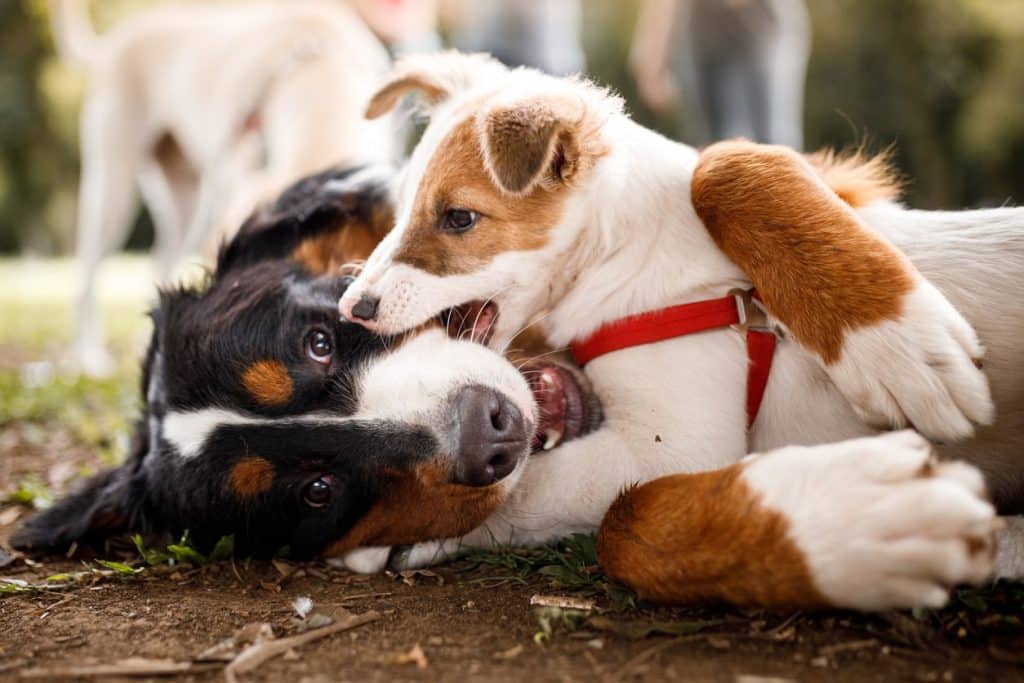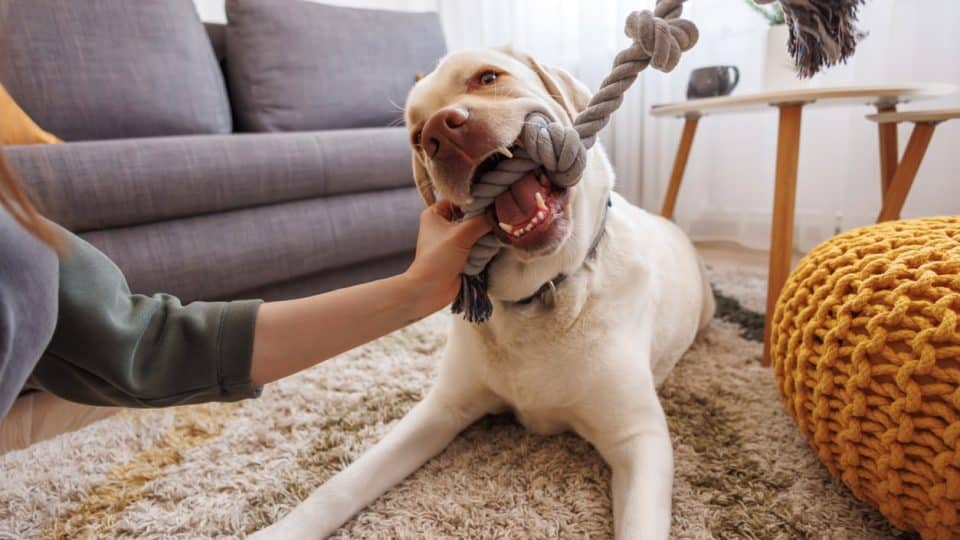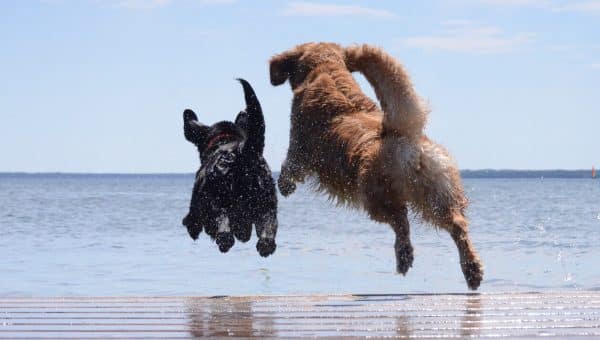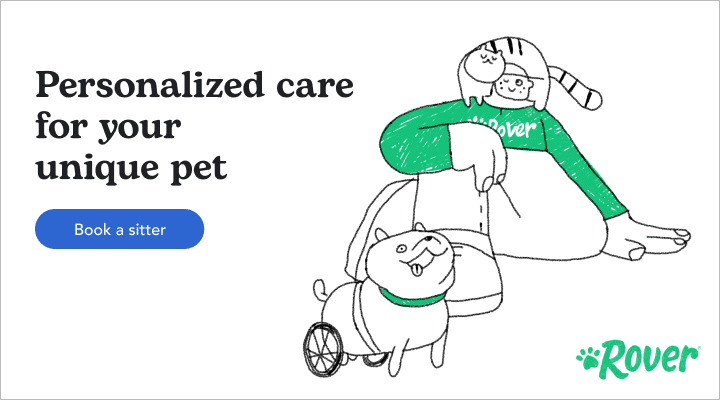- Not a substitute for professional veterinary help.
Dogs are considered man’s best friend, but what happens when that friend bites? It’s an uncomfortable reality to consider, but all dogs are capable of biting—even the most good-natured and docile of dogs. Learning how to prevent dog bites starts with understanding why they bite in the first place. There are a number of reasons why dogs bite, most of them stemming from fear or discomfort, says Dr. Christine Calder, DVM, DACVB, a board-certified veterinary behaviorist.
The best way to prevent dog bites? Learning to read (and respond to) a dog’s body language. It’s also critical to learn how dogs communicate, to respect their boundaries, and to always practice appropriate caution with unfamiliar dogs.
Below, we’ll dive into why dogs bite and how to prevent them from biting in the future.
Why Do Dogs Bite?
Preventing dog bites starts with understanding why your dog bites. Over 4.5 million dog bites occur in the United States every year. While bites pose a serious danger, there are ways to keep you and your family safe.
First, it’s worth noting that aggressive behavior doesn’t mean your dog is inherently “bad.” Rather, they’re likely feeling insecure about a particular stimulus. Aggressive behaviors like barking, lunging, and biting are used to communicate a dog’s emotional state. Dr. Calder explains that most dog bites happen because a dog is feeling unsafe or unwell.
Here are four of the most common reasons dogs bite.
Fear and anxiety
Dr. Calder says most dog bites are a reaction to fear or anxiety. These emotions may be triggered by anything the dog perceives as a threat, whether that’s a person, another animal, or a frightening environment. When a dog is scared or uncertain, they may use a bite as a “distance-increasing” strategy. In other words, they are trying to make the perceived threat move farther away. Some dogs find that this strategy works well for them and will revert to aggression in the future.
Illness or pain
Dr. Calder says dogs may also bite when they’re in pain from an injury or underlying medical condition. They might be frustrated with the discomfort or afraid that an approaching person will cause more pain.
Protective maternal instinct
A dog who has recently given birth may instinctively lash out to protect her puppies. Even if the mother dog knows you, she may bite if she thinks her puppies are being threatened.
Resource guarding
Resource guarding, also called possessive aggression, is a natural canine behavior rooted in their ancestral survival instincts. A dog’s desire to guard items they consider valuable (toys, food, a bed) may also be tied to a personal history of scarcity.
It’s not always problematic, but if your dog’s possessiveness becomes dangerous, it might be time to work with a professional trainer or dog behaviorist. They can help you utilize desensitization and counterconditioning techniques to curb aggressive behavior.

iStock/cunfek
What Are the Signs a Dog Is About to Bite?
Although dogs can’t speak, they can communicate through body language, posture, and vocalizations. Therefore, it’s critical to pay attention to the warning signs dogs use to let us know they’re feeling frightened or threatened before they resort to biting. “Often [a bite] is prefaced by a growl, snarl, attempt to retreat, and/or other body language cues,” Dr. Calder says.
A dog about to bite may also:
- Bare their teeth
- Growl
- Exhibit stiff body posture
- Hold a direct stare
- Hold their tail up straight
- Have raised hair on their back
- Press their ears tightly against their head
- Lick their lips
- Lunge
- Attempt to move away from the perceived threat
Along with these warning signs, dogs may give what’s called a “pre-bite” or warning bite. This is where they snap at the air without making contact or biting down on someone. If you observe air-biting, the situation should be addressed before it escalates into an actual bite. However, never punish your dog for displaying this warning sign. Otherwise, you may encourage them to go straight to biting without any warning.
You may also notice your dog nipping, growling, or baring their teeth while engaged in play. Playful mouthing can look a lot like aggression, but it’s considered a normal behavior. “It can sometimes be hard to differentiate this when dogs are playing,” says Calder. “But there are some telltale signs in how the dogs interact that can provide more information as to what is really going on between the dogs.”
While playing, the dog’s body and face will be loose and relaxed rather than stiff. Playful bites will be quick, with the dogs’ heads turning away from each other. An aggressive dog, on the other hand, will have a stiff body and bite down directly and forcefully.
How to Respond to a Dog Bite Before It Happens
When your dog is displaying pre-bite signs, remove the source of your dog’s stress or move your dog away from their trigger. To move your dog away, you can make an emergency U-turn by throwing a treat on the ground in the opposite direction.
If you notice warning signs while your dog is off-leash (say, at the dog park or in the yard), intervene immediately before tensions escalate. Try using a treat or a toy to distract your dog away from an unfriendly interaction.
If a fight happens to break out, never separate dogs with your bare hands. Instead, use a hose, a broom, a piece of cardboard, or anything you can wedge between them without putting yourself at risk of getting injured. You may also want to consider carrying a break stick, which can be used to prevent a dog from biting down on another person or animal.
After you’ve removed your dog from the situation and done any necessary bite aftercare, refrain from punishing them. Instead, schedule a vet checkup to rule out medical conditions. Then, consider working with a fear-free trainer or certified dog behaviorist to work on behavior modification.

iStock/Capuski
How to Reduce the Chance of Dog Bites
“When it comes to aggression in dogs and subsequent bites, the first step is to determine the motivation,” Dr. Calder says. Determining the motivation may require a visit to your veterinarian or a behaviorist.
Then, once the cause of your dog’s aggression is identified, management can involve helping the dog feel safe by avoiding specific triggers. “We then teach new behaviors to improve communication, increase predictability, and provide consistency in interactions,” she says. Sometimes, medications are needed to treat a dog’s underlying anxiety or frustration.
Socialization also comes into play. Without regular exposure to different people, places, and animals, dogs can become frightened easily by ordinary things and events—which may make them likely to bite or act aggressively out of fear. One of the most important things you can do to prevent aggression is to get your dog comfortable in a variety of settings and introduce them to the different sights and sounds they might encounter.
The key to successful socialization is to proceed gently and to let your dog set the pace. Watch for signs of discomfort, and never push your dog into an uncomfortable situation before they’re ready.
How to reduce biting risk during play
When two dogs are playing together, stay tuned in to their body language. If you notice warning signs—stiff bodies, curled lips, growling—remove them from the situation. If things escalate and you have to break up a dog fight (and it’s safe for you to do so), try shouting and making a loud noise with nearby objects. You can also use a chair, board, or other object to create a barrier between them.
How to reduce biting while on the leash
The key to managing a leash-reactive dog is keeping them under their reactivity or stress threshold. A dog who is “over threshold” may lunge or snap at another dog while on leash. You can use a few techniques to keep their stress to a safe minimum.
- Walk at off-peak hours: If possible, avoid high-traffic areas and try walking in the early morning or later in the evening.
- Give your dog space: Keep your dog at a comfortable distance from their trigger on walks. If a dog is walking towards you, cross the street or do a U-turn.
- Reward eye contact: Give your dog a treat every time they look in your direction. This helps keep your dog focused on you instead of their trigger.
- Use a harness or head collar: When used correctly, a Gentle Leader can redirect dogs faced with an agitating stimulus. A well-fitted dog harness can also offer greater control.
- Use a “Do Not Pet” collar: This is a simple and effective way to keep well-meaning folks from approaching your pet.
How to reduce biting risk at home
To diffuse stress at home, you can create a safe haven for your dog. This gives them a designated place to retreat during potentially triggering events like storms, fireworks, or the arrival of guests. This can be a crate or bed that’s set away from high-traffic areas. You can also give your dog a stress-reducing lick mat or a treat-dispensing dog toy to distract them and create positive associations with their safe space.
If you have young children in your home, always supervise them around dogs—even if your dog has never exhibited aggressive behavior before. Teach children how to behave around dogs. Make sure they understand we never tease dogs and that we leave dogs alone when they’re eating or sleeping.
Parents of reactive dogs can also take the following safety precautions:
- Always keep your dog on a leash during walks
- Supervise dogs outdoors—even in a fenced yard
- Identify (and avoid) triggers
- Don’t force dogs into situations where they feel uncomfortable
- Avoid the use of aversive tools and punishment-based training methods
- If a certain trigger is unavoidable, consider desensitizing your dog to a muzzle
- Seek professional help: a qualified dog trainer or animal behaviorist can help you pinpoint triggers and develop a plan

iStock/kosobu
How to Avoid Being Bitten By a Dog
The key to avoiding a dog bite is to never assume any dog is 100% safe. No matter how approachable and friendly they may look, all dogs are capable of biting—even dogs you’ve been previously acquainted with. As we’ve noted, a number of factors can contribute to a moment of aggression, so it’s always better to err on the side of caution.
- Be mindful of your posture and movements around dogs
- Avoid bending over them or putting your face close to a dog’s face
- Never greet dogs with an outstretched arm; these gestures can feel confrontational to some dogs
- Don’t make any jerky, erratic movements, as this can make dogs nervous
- Ask the pet parent if it’s ok to pet their dog
If they seem hesitant, take it as a polite “no.” They may feel awkward saying no or admitting their dog might react negatively.
Finally, if you encounter an unfamiliar dog exhibiting fearful or aggressive behavior, stay calm and “be still like a tree”. Don’t move suddenly or run away, as this may encourage the dog to chase you. Avoid direct eye contact, avert your gaze, and don’t make loud noises. Once the dog loses interest, you can back away slowly.
All of these should help you prevent getting bitten by a dog in the future, but as always, every dog is different, so if you’re ever unsure, err on the side of caution.





